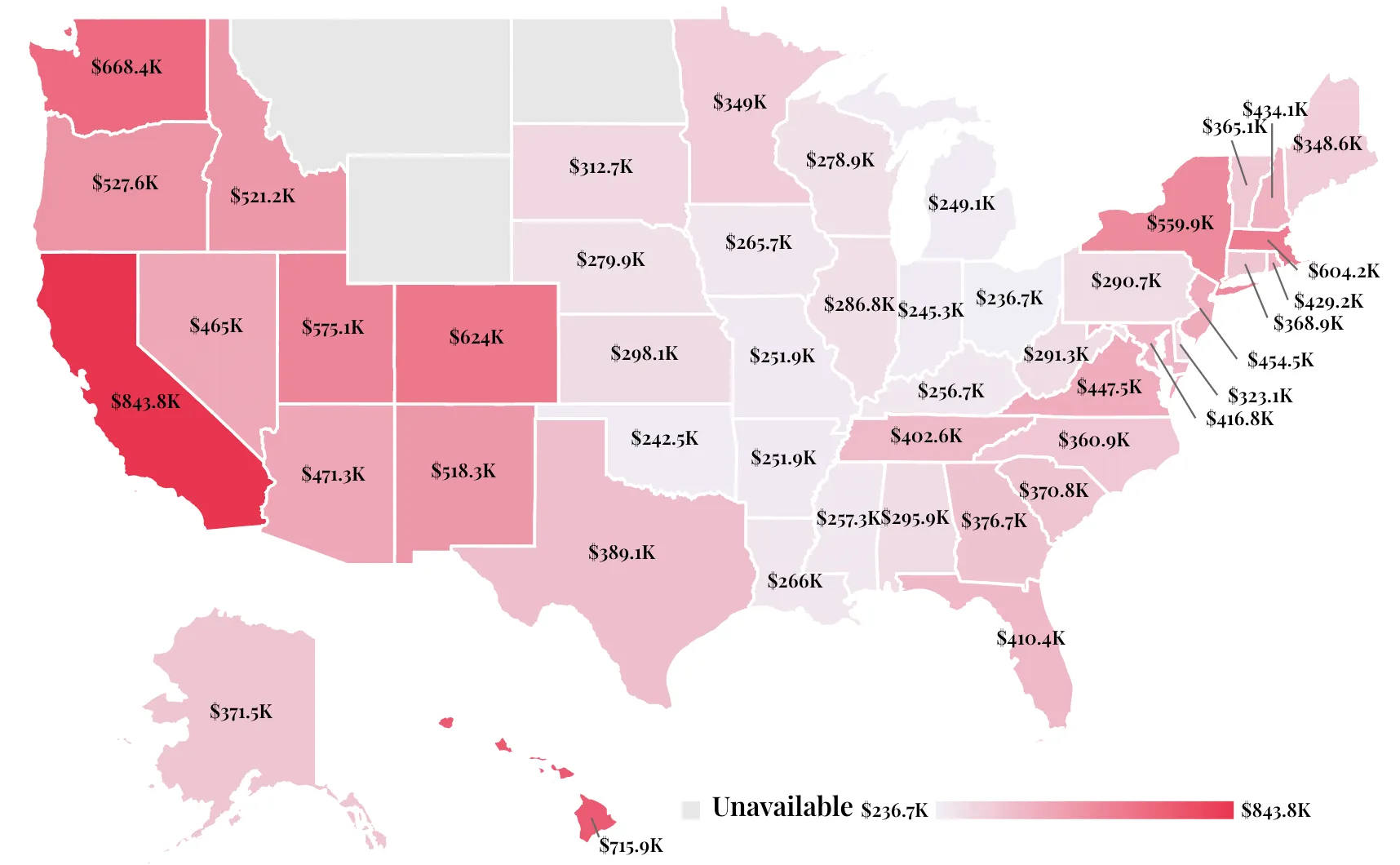The Wisconsin housing market is no stranger to change and fluctuations as we see the same housing patterns across the nation. As we approach 2024, many potential homebuyers and sellers are eager to know what the future holds. While no crystal ball can provide a perfect prediction, we can analyze current trends and historical data to make informed forecasts about the residential real estate market in Wisconsin for 2024.
Understanding the Current Landscape

Median Home Price by State
Source: https://wisevoter.com/state-rankings/median-home-price-by-state/
Before we dive into the potential housing market forecast, it’s essential to consider the factors influencing the real estate landscape in Wisconsin. In early 2022, the state, like many others, experienced shifts due to the COVID-19 pandemic. With the economy still in an uncertain state, here are some key factors to keep in mind:
- High Mortgage Rates: While mortgage rates remain historically low, they have climbed in recent months to stabilize with inflation, generating some hesitation among prospective house buyers. Homeowners with lower-rate mortgages have stopped listing their homes for sale which has led to home prices being unaffordable for more buyers.
- Low Inventory Levels: Inventory levels were a significant concern in the housing market. A limited supply of homes in certain areas has led to increased competition among buyers and rising home prices.
- Uncertain Economic Conditions: Wisconsin’s economy, like the rest of the nation, plays a vital role in the housing market. Factors such as employment rates, income levels, and overall economic stability can impact the ability of residents to buy or sell homes. With higher inflation affecting rent and housing, the Fed is working to hold interest rates steady. Mortgage rates climbed in comparison with the Fed’s string of rate hikes.
Overall, we have seen a more cautious and informed buyer market. Sales volumes have been decent, but there have been a few plateaus, indicating market saturation in certain sectors. Even people who are willing to pay high prices have been less likely to purchase a home, and sellers have been less likely to sell due to lower interest rates.
In the coming year, housing affordability will be influenced by home prices, mortgage rates, economic and inventory levels. Where are these trends leading? Let’s discuss the housing market forecast for 2024.
2024 Housing Market Forecast for Wisconsin
While we can’t predict the future with certainty, we can make educated guesses based on current trends. Here are some potential scenarios for the Wisconsin housing market in 2024:
Increased Interest in Wisconsin
Given historically low mortgage rates, it’s possible that demand for residential real estate in Wisconsin will remain steady. People will continue to seek homeownership, particularly if mortgage rates dip. Additionally, declines in mortgage rates could spur sellers to trade their existing homes, which would benefit low inventory challenges.
“Retreating mortgage rates will bring more buyers and sellers to the market and get Americans moving again,” says NAR (National Association of Realtors) chief economist Lawrence Yun. While this may be true, we aren’t expecting sales to increase dramatically.
Nationwide, between August 23 and October 23, 2023, 25% of homebuyers looked to relocate to a new metro region. Approximately 3K people searched to move to Wisconsin rather than move away from the state. It has even been noted that many Gen Zers are looking to leave expensive, bustling cities for a quiet, less-expensive life in the Midwest or Mountain regions. While Gen Z is still a very renter-majority generation, they had a 74% share and 4.5 million renters added in the last five years, which is more than any other age group. While 52% of Millennials are homeowners, they were the largest generation in the nation that transitioned from renter-majority to owner-majority in 2022.
These two generations have consistently shown more interest in the Midwest, South, and middle-metro regions and if the market continues in their favor, there could be a substantial increase in Wisconsin homeowners in 2024.
Inventory Challenges
If inventory levels do not increase significantly, we may continue to see competition among buyers, leading to rising home prices. The nation had a 3.4-month supply of housing inventory as of September 2023, per NAR, which is low enough to be considered a seller’s market. Sellers could benefit from a seller’s market, but buyers may face challenges.
To dramatically boost inventory levels, either a surge of homeowners listing their existing houses or a large number of new-construction homes entering the market would be required.
Economic Uncertainty on Housing Prices
The overall economic health of Wisconsin will be a key determinant. A robust economy with strong job growth can support the housing market by providing residents with the means to invest in real estate. But with the Fed’s war on inflation, as long as the economy continues to chug along, this new normal will likely be adjusted to.
That is the catch though, the economic uncertainty is still looming for 2024 nationwide. So will home prices rise or decrease in 2024? While some experts anticipate a decrease due to factors like demand, affordability issues, and economic uncertainty, other experts predict that housing prices will rise due to continued high demand and relatively low supply. There is no clear direction where housing prices will end up, but we can be mindful of trends to predict that demand and economic stability will be a huge factor.
The median home price (nationally) in September 2023 of $394,300 was only around $20K short of the highest monthly home price ever recorded by NAR ($413,800 in June 2022). While, the median price of a home in Wisconsin in July 2023 was $300,000, a 7.5% rise from the previous year, which is comparable to the national average. Southeastern Wisconsin was the most popular place to buy a home in Wisconsin in 2023.
Local market conditions, job trends, and regional dynamics will all have a substantial impact on the trajectory of property values.
Changing Government Policies
Government policies and regulations can have a substantial impact on the housing market. Changes in tax policies, lending regulations, and other factors could influence the market in unforeseen ways. The U.S. inflation rate as of September 2023 was 3.7 percent — still a bit higher than the Fed’s stated goal of 2 percent.
High mortgage rates, high property prices, and low inventory levels are all conspiring to make the 2024 housing market challenging for both buyers and sellers. However, if interest rates fall in 2024, as some experts believe, market activity will rise in reaction.
What Can Homebuyers and Sellers Do?
Whether you’re looking to buy or sell a home in Wisconsin in 2024, it’s essential to stay informed and be prepared for different scenarios. Here are some tips to consider:
- Stay Informed: Keep a close eye on real estate news and market trends. Regularly check for updates on mortgage rates, inventory levels, and economic conditions. Keep a close eye on real estate news and market trends. Regularly check for updates on mortgage rates, inventory levels, and economic conditions.
- Financial Readiness: Ensure your financial situation is in good order. Whether you’re buying or selling, having your finances in order can make the process smoother.
- Local Expertise: Work with a local real estate agent who has a deep understanding of the Wisconsin market. They can provide valuable insights and guide you through the process.
- Flexibility: Be prepared to adapt to changing market conditions. If you’re a buyer, you might need to adjust your expectations, and as a seller, you might need to adjust your pricing strategy.


